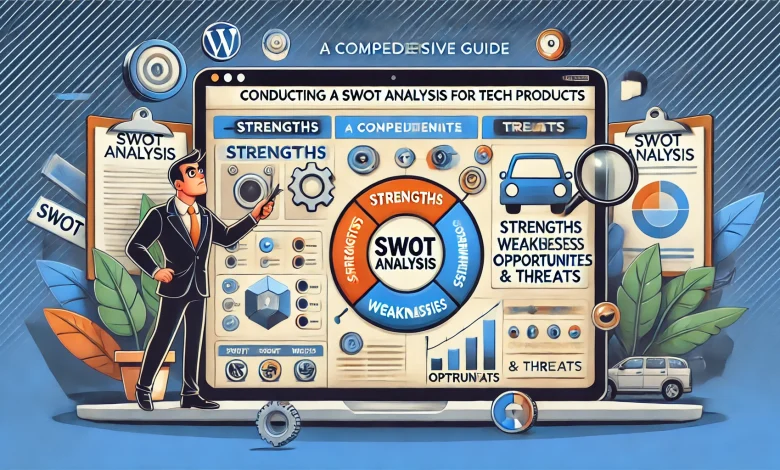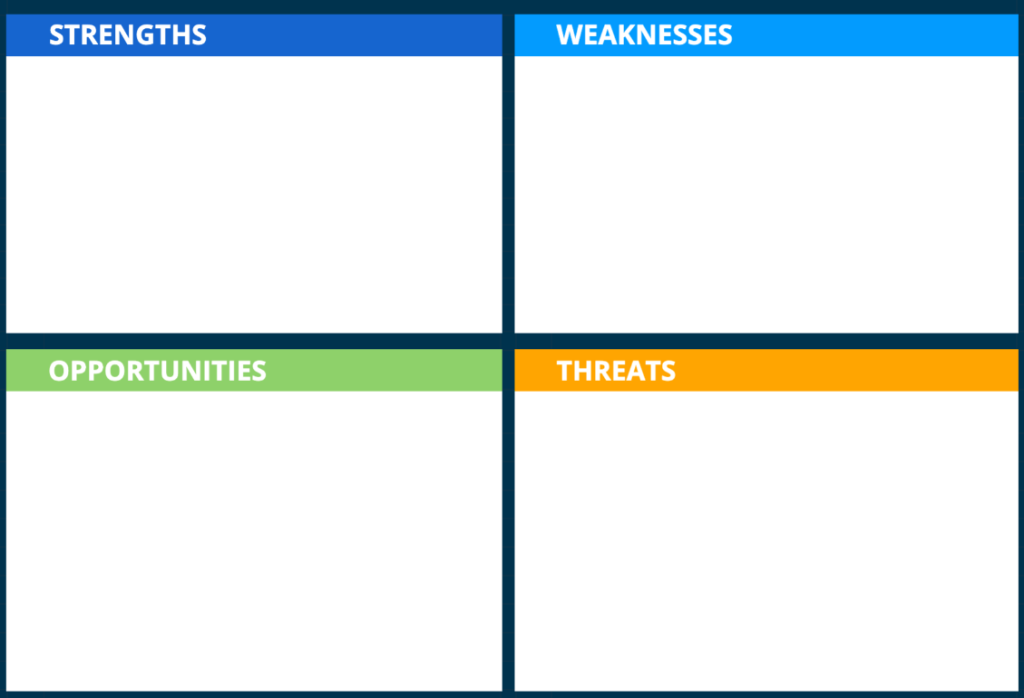Conducting a SWOT Analysis for Tech Products: A Comprehensive Guide

Introduction: Why SWOT Analysis Matters in Product Management
As a product manager, one of the most valuable tools at your disposal is the SWOT analysis. It provides a structured way to assess your product’s Strengths, Weaknesses, Opportunities, and Threats.
While many product managers are familiar with the basic framework, fewer understand how to fully leverage it for long-term success, especially in tech, where rapid innovation, intense competition, and constant market shifts are the norm.
This article explores how to conduct a SWOT analysis for tech products in depth, how it integrates with your broader product strategy, and how to turn insights into actionable outcomes.
What is a SWOT Analysis?

At its core, a SWOT analysis is a strategic planning tool that evaluates the internal and external factors impacting a product. It breaks down into four components:
- Strengths: What gives your product a competitive edge?
- Weaknesses: Where are the internal limitations or areas of improvement?
- Opportunities: What external factors can you capitalize on?
- Threats: What external risks could impede your product’s success?
The Importance of SWOT Analysis in Product Management
For tech products, conducting a SWOT analysis is critical because it aligns internal capabilities with market dynamics. It not only helps identify where your product stands but also provides a roadmap for addressing gaps, exploiting opportunities, and mitigating risks. Whether you’re launching a new feature, expanding into new markets, or planning strategic pivots, a well-executed SWOT analysis informs key decisions.
Breaking Down the Four Components of SWOT
- Strengths: Consider factors like proprietary technology, market share, or unique features that differentiate your product.
- Weaknesses: Address product limitations like technical debt, usability issues, or lack of integrations.
- Opportunities: Look for emerging technologies, untapped markets, or evolving customer needs that your product can exploit.
- Threats: These could include increasing competition, changing regulations, or technological disruptions.
Tailoring SWOT Analysis for Tech Products
Unlike traditional industries, tech products face rapid innovation cycles and high levels of competition. As such, your SWOT analysis needs to account for the following:
- Technological Dependencies: How reliant is your product on third-party APIs, cloud services, or outdated frameworks?
- Market Saturation: Is your niche crowded, and if so, how can your product stand out?
- Innovation Trends: Consider the pace of change in your sector—can your product keep up with AI, machine learning, or IoT developments?
Incorporating AI and Data Analytics into SWOT Analysis
One of the most significant advancements in modern SWOT analysis is the integration of AI and data analytics. By using predictive analytics, machine learning, and sentiment analysis, you can enhance your SWOT analysis by making it more data-driven. For example:
- Strengths and Weaknesses: Use AI tools to analyze customer feedback and performance data to identify trends in product usage, allowing you to fine-tune what’s working and what needs improvement.
- Opportunities and Threats: Apply predictive models to market data to forecast trends or identify emerging competitors before they become a serious threat.
Leveraging Market Research in SWOT Analysis
Market research is crucial when evaluating opportunities and threats in your SWOT analysis. Data on customer preferences, industry trends, and competitive behavior should feed directly into your analysis. Here’s how:
- Customer Insights: Identify unmet needs through surveys, user interviews, or behavior tracking.
- Competitive Benchmarking: Compare your product’s strengths and weaknesses against industry leaders.
- Industry Reports: Use reports from Gartner or Forrester to validate or challenge your assumptions about market opportunities and threats.
Using SWOT to Inform Product Roadmaps
The results of your SWOT analysis should directly inform your product roadmap. Here’s how:
- Strengths: Double down on features or capabilities that customers love by prioritizing them in future releases.
- Weaknesses: Allocate resources to address shortcomings such as performance issues or usability improvements.
- Opportunities: Focus your roadmap on innovations that align with emerging market trends or customer demands.
- Threats: Develop contingency plans for threats like new competitors or regulatory changes.
Conducting Competitive SWOT Analysis

A SWOT analysis is not only about your product—it’s also about understanding your competitors. By conducting a competitive SWOT analysis, you gain insights into where you stand in the market:
- Strengths vs. Competitor Weaknesses: Can you exploit areas where your competitor is falling short?
- Opportunities in Their Threats: If a competitor is struggling with market adoption due to poor customer service, could you capitalize on that by offering superior support?
SWOT Analysis for AI-Driven Products
When conducting a SWOT analysis for AI-driven products, specific factors come into play:
- Data as a Strength: If your AI model is built on a large, high-quality dataset, that’s a significant strength.
- Algorithmic Bias as a Weakness: One of the greatest weaknesses of AI-driven products is the risk of bias in algorithms, which could lead to poor decision-making or even reputational damage.
- Opportunities in AI Advancements: With AI technology evolving rapidly, your product can benefit from new algorithms, cloud-based machine learning services, or edge computing.
- Threats from Regulation: Increasingly stringent data privacy laws, such as GDPR, pose a potential threat to AI-driven products that rely on vast amounts of user data.
Addressing Technical Debt in the SWOT Framework
In tech products, technical debt can act as both a weakness and a threat:
- Weakness: Identify areas of your product where legacy code or poor architecture is causing inefficiencies.
- Threat: If technical debt isn’t addressed, it could slow down future development and make it harder to scale.
Turning SWOT Analysis into Strategic Opportunities
A critical next step after completing your SWOT analysis is to translate findings into strategic actions:
- Weakness to Opportunity: Can a weakness, like a limited feature set, become an opportunity for innovation or expansion?
- Threat to Strength: Is there a way to turn an external threat, such as increased regulation, into a product feature, such as offering compliance management as part of your solution?
Best Practices and Practical Examples
Case Study: SWOT Analysis of a Successful Tech Product
Consider a SaaS product that has recently gained traction in the project management space. Here’s a breakdown of their SWOT analysis:
- Strengths: Intuitive user interface, integrations with popular tools, and a strong community-driven approach.
- Weaknesses: Limited mobile functionality and performance issues at scale.
- Opportunities: Expanding into the growing remote work sector and developing mobile-first features.
- Threats: Established competitors like Asana and Trello, and potential security vulnerabilities as the user base grows.
From this SWOT analysis, the product team focused their roadmap on addressing the weakness of mobile functionality and pursuing the opportunity of expanding into the remote work market. They also implemented stronger security features to mitigate potential threats.
Tools for Conducting a SWOT Analysis
There are numerous tools and platforms that can simplify the SWOT analysis process:
- SWOT Analysis Software: Platforms like Miro or Lucidchart allow for collaborative SWOT analysis with visual tools like matrices and flowcharts.
- AI-Driven Tools: Products like Crimson Hexagon or Amplitude leverage AI and big data analytics to provide deep insights into product strengths, weaknesses, and customer behavior trends.
Conclusion: Making the Most of SWOT in Tech Product Management
A SWOT analysis is more than just a strategic tool—it’s a roadmap to product success. When done correctly, it enables product managers to make data-driven decisions, identify gaps, and stay ahead of market changes. Whether you’re launching a new product or refining an existing one, integrating SWOT into your product management process ensures that your product aligns with market needs and is positioned for long-term success.

